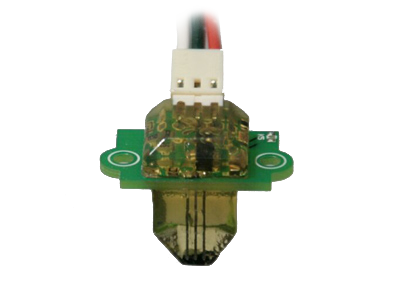SpeedpulsSpeedometer moduleV-signal encoderVSS sensor
Digital speedometer signal for the VW Bulli T3 or for vehicles with identical speedometers.

Digital speedometer signal in only 10 minutes
Sensor and electronics are cleanly encapsulated and are therefore insensitive to vibrations, shocks and moisture.
Speedpuls Features
in any temperature, in wind and weather and on all trails.

Non-contact scanning
Exact fit
LED function control
Reverse polarity protection
How can the Speedpulse be used?!
NAVIGATION SYSTEME
- Alpine
- Becker
- Blaupunkt
- Clarion
- Medion
- Pioneer
- VDO
- VW Multifunktionsdisplay (MFD)
So far, EVERY Navi has worked with the module. 100% success rate!
CRUISE CONTROL
- VDO (12V-Variante benötigt)
- VW Original Tempomat (z.B. Carat)
- Waeco MS 50
- Waeco MS 200/300/400 (12V-Variante)
- Zemco Pilotomat
ENGINE CONTROL UNITS
- Motorkennbuchstabe AFN, 1Z, ... (12V-Variante)
- bisher war praktisch jeder Volkswagen Motor zwischen 1993 und 2005 kompatibel
- Siemens (SiMos) Steuergeräte (ADY) benötigen die 5V-Variante des Moduls
- Bosch Steuergeräte benötigen die 12V-Variante des Moduls
- Subaru-Umbau auf EJ22, EJ25, EG33 (5V-Variante)
VEHICLES
- Golf 1 after Model year.84
- Golf 2
- VW Bus T3
- Vehicles with identical tachometers such as Caddy or Jetta.
- Special mounting is possible for the Beetle 1303
TDI-ECU
- 1Z, AFN, ADY, AHU, und alle anderen...
The technique
How does the Speedpuls work
Installation position
The module is screwed into the existing opening of the speedometer for the VW Gala encoder. The speedometer itself does not need to be modified or processed, only the locking tab is removed, which closes the installation opening if necessary.
The installation of the module can be easily reversed. In other solutions, speedometer shafts are cut through and crimped again, or dividing gears are used; all this is unnecessary here.
The module works completely contact-free. With comparable solutions, there is often a "tremor" of the speedometer needle due to engagement with the speedometer cable. This is excluded here.
Differences to the VW GALA encoder
The GALA sensor from VW is based on an inductive sensor principle, similar to a bicycle dynamo. The magnetic field of the disc induces an alternating voltage in the coil of the sensor whose frequency depends on the speed of the speedometer cable.
The disadvantage of this solution follows from the similarity to the dynamo: The signal level also depends on the speed!
Especially when driving slowly, the Gala encoder only generates signal levels of significantly less than 5V, which can no longer be processed by most terminal devices. There are so-called "pulse doubler relays" available that compensate for this disadvantage, but the cost of these alone is already over 50 euros, if you can still get them at all.
Operating principle Hall sensor
Der Hallsensor hat nichts mit Schall im Sinne von Echo zu tun, sondern ist nach seinem Erfinder Edwin Hall benannt. Basierend auf dem Hall-Effekt reagiert der Sensor auf magnetische Felder und tastet die mit der Tachowelle rotierende magnetische Scheibe im Serientacho ab.
Das "Hall-Plättchen" ist in die Spitze des Sensors eingegossen und wird auf die vorhandene Magnetscheibe im Tacho gerichtet. Diese Scheibe rotiert mit der Tachowelle und bildet den magnetischen "Mitnehmer" für die Tachonadel.
Die Scheibe ist sektorweise magnetisiert und weist pro Umdrehung der Tachowelle vier magnetische Südpole auf, die den Hall-Sensor aktivieren, es entstehen also vier digitale Impulse pro Umdrehung der Tachowelle.
Da das Sensorprinzip hier allein die Anwesenheit eines Magnetfeldes voraussetzt und nicht davon abhängig ist wie schnell diese Magentfeld sich ändert, ist auch die Höhe des Signalpegels unabhängig von der Geschwindigkeit. Dies garantiert ein sauberes Geschwindigkeitssignal bis zum Stillstand des Fahrzeuges.
Das Modul ist mit einem 5V Spannungsreglern ausgestattet und produziert zunächst ein Ausgangssignal mit 5V. Alternativ kann der Spannungsregler abgeschaltet werden, dann entspricht der Ausgangssignalpegel der eingehenden Bordspannung (12V). Dieses "Abschalten" geschieht durch das setzen einer einzelnen Lötstelle und ist jederzeit auch nachträglich noch machbar.
Bei der 5V Variante werden Schwankungen der Bordspannung bis auf weniger Millivolt ausgeregelt.
Die Schaltung verfügt über einen Verpolungsschutz und kann bis max. 16V (dauerhaft) Eingangsspannung sicher betrieben werden. Kurzzeitig dürfen auch bis zu 24V anliegen.
Nach dem Einbau kann die Funktion des Moduls unmittelbar durch die eingebaute LED kontrolliert werden. Beim drehen der Tachowelle von Hand bzw. mit einem kleinen Schraubendreher blinkt die LED vier mal pro Umdrehung.
Diese Lösung ist entschieden billiger als eine geteilte Tachowelle, viel weniger aufwändig und robuster als angeklebte Magnete mit Reedschaltern und präziser als der GALA-Geber.
Sie erhalten ein fertig aufgebautes, eingestelltes und getestetes Modul mit ca. 50cm Anschlusskabel und Montagematerial.
Distance number
The different speedometers are marked with a distance number (k-number) - this is the small number on the dial directly above the reset button of the trip odometer. The number indicates the number of speedometer shaft revolutions per kilometer.
Modern applications use what is called the distance impulse number (WIZ), which is a specific number of electrical impulses per kilometer. Typical for VW vehicles (TDI) is a WIZ of about 4000 pulses per kilometer.
In order to be able to offer the 4000 pulses/km for each tachometer as far as possible, there are two versions of the Speedpuls module: The SP-T3-4P and the SP-T3-8P module.
The 4P module generates 4 electrical pulses per speedometer shaft revolution. With a k-number of approx. 1000 (T3-Syncro, Golf2, etc) this results in 4000 pulses per revolution.
The 8P module generates 8 electrical pulses per speedometer shaft revolution. With a k-number of approx. 500 (T3-2WD) 4000 impulses per revolution are generated.
Of course, other combinations are conceivable:
2WD speedometer: W=500 ⇢ 500 speedometer shaft revolutions per km ⇢ with 4P module ⇢ 2000 pulses per km
2WD speedometer: W=500 ⇢ 500 speedometer shaft revolutions per km ⇢ with 8P module ⇢ 4000 pulses per km
4WD speedometer: W=1000 ⇢ 1000 speedometer shaft revolutions per km ⇢ with 4P module ⇢ 4000 pulses per km
4WD speedometer: W=1000 ⇢ 1000 speedometer shaft revolutions per km ⇢ with 8P module ⇢ 8000 pulses per km
Golf2 speedometer: W= 960 ⇢ 960 speedometer shaft revolutions per km ⇢ with 4P module ⇢ 3840 pulses per km
By selecting the right module for the respective speedometer, a sufficiently accurate WIZ can usually be generated.
Navigation systems are unproblematic, they calibrate themselves via GPS to any offered distance pulse number.
Where can I buy this ingenious piece?
The Speedpuls is available through the following authorized dealers
Germany and International:
MyBusParts Bernd Jäger

Speedbullz Customs

Mein Bauchladen

Canada & USA:
Fast Forward Automotive



